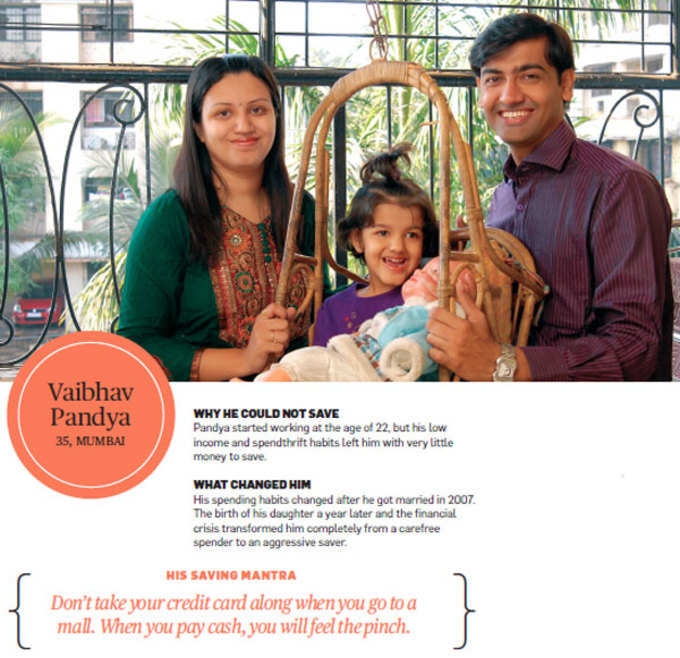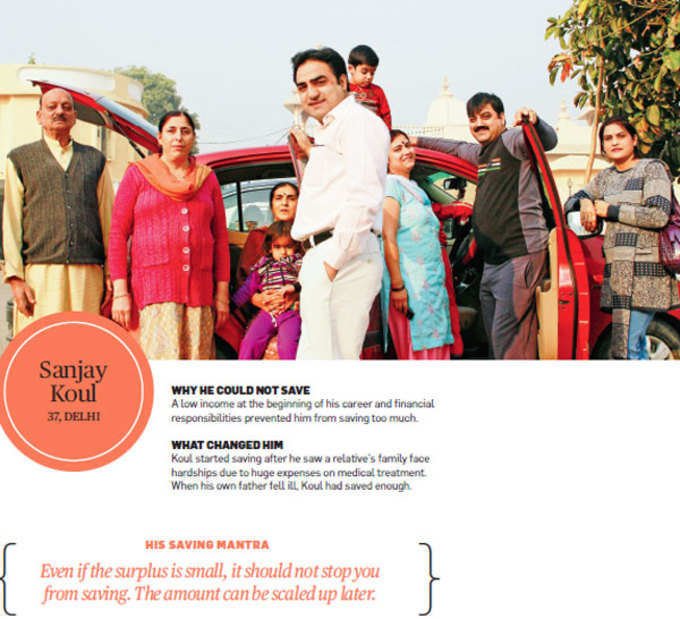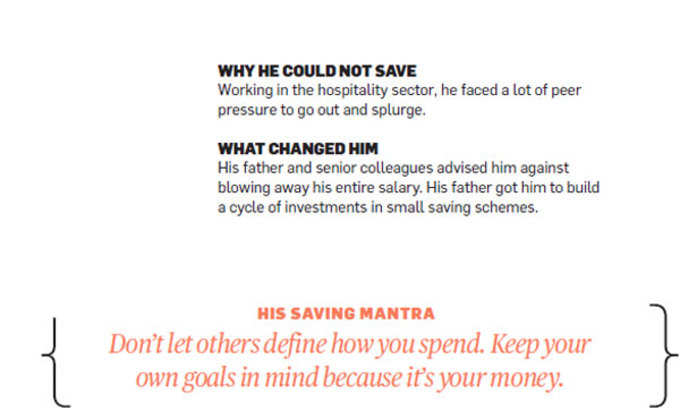“Gen Y focuses on their EMIs, but ignores their
Discipline and self-regulation are the cornerstones of a successful investment plan. We know it is difficult to salt away money when everyone around you is spending as if there is no tomorrow. There is tremendous peer pressure and even the most level-headed youngsters can stumble. Our cover story this week looks at 8 secret mantras that can help transform a spendthrift into a saver.
MANTRA 1: SAVE BEFORE YOU SPEND
Many people are not able to save enough because they don’t have anything left after all their expenses. Their financial equation is: Income - Expenses = Savings. Legendary investor
We know controlling expenses is easier said than done. However hard you may try, there will be some expense that will gobble up the surplus and prevent you from saving. The solution lies in automating your savings.
If you give an ECS mandate to your bank for an SIP, the money will automatically flow into your mutual fund even before you can withdraw it. Ideally, the savings should flow into an investment option that does not allow easy withdrawals. This is one of the reasons that make the
MANTRA 2: WAIT BEFORE YOU SPLURGE
The urge to buy something you like can be overwhelming. Easy financing options and plastic money prevent an individual from distinguishing his wants from his needs. Whenever you want to buy something expensive but not essential, follow the 30-day rule. Just postpone the purchase by 30 days.
During that period, think hard whether you really want the item. At the end of the month, if you still want to buy it, go ahead and purchase it. However, if the item was not really essential, you will get over the urge to buy and will probably junk the idea.
This simple rule works very effectively in case of gadgets, apparel, footwear and accessories. It’s also not very difficult to follow because you don’t actually deny yourself the item. You merely postpone the purchase by a month. As a fringe benefit, you also get to research the item over the next 30 days.
MANTRA 3: AVOID USING PLASTIC MONEY
Credit and debit cards are essential because an increasing number of our financial transactions take place online. However, plastic can be dangerous in the hands of a reckless spender. Studies show that even normal people tend to overspend if they use a credit card for a purchase. If they have to make the payment in cash, they will feel the pinch more. Since the credit card user only signs on the slip, the full impact of the purchase is not felt.
To suppress the shopaholic inside you, leave your debit and credit cards behind when you go to the mall. Take cash instead. Mumbai-based IT professional Vaibhav Pandya (see picture) has followed this simple rule for the past 6-7 years and seen his savings shoot up. He says paying cash makes him think twice before he makes a purchase.

Experts recommend some extreme measures for serious shopping addicts. Some say you should just note down the card details and then cut the card into pieces so that you can’t use it anymore. Others suggest you keep the card in a paper sleeve and stick pictures of your kids or spouse on it. You will be reminded of the other goals you may be jeopardising when you swipe the card for an unnecessary purchase.
“Keep in mind that every craving sets you back when it comes to reaching your long-term goals,” says P V Subramanyam, financial trainer, Iris. One bizarre idea is to literally freeze your card inside a block of ice. It won’t damage the card, but the user will have to wait for the ice to melt before he can access it. However, we believe the average spender won’t have to resort to such extreme measures. Just keeping the card in a safe place instead of carrying it around in the wallet is good enough.
MANTRA 4: START SMALL TO SAVE BIG
At the beginning of your career, your income is not very high. In many cases, there is a very small investible surplus after the expenses. Still, this does not hold you back from saving. Delhi-based Sanjay Koul (see picture) was not able to save much in his initial years of earning because his income was low and there were too many financial responsibilities.

Yet, he managed to put away a small amount every month. For a young investor, the low quantum of investment is more than made up by the long period available for the money to grow. The magic of compounding ensures that even a small sum grows into a gargantuan amount over the long term. The investment can be scaled up as the income grows in the coming years. Turn to page 18 to know how even a modest investment of Rs 3,000 a month in an option that gives a conservative 8.5% can balloon to over Rs 1.5 crore in 30 years if you just keep increasing the investment by 10% every year.
MANTRA 5: DON’T BE PRESSURED TO SPEND
Everybody’s financial situation is different. Just because your colleague has bought a new car or booked a flat in a fancy location does not mean you should follow suit. Bangalore-based Rajesh Prasad (see picture) learnt this early in his career. “When I started working, there was a lot of peer pressure to go out and splurge. However, my father and senior colleagues advised me against blowing away my entire income,” he says.
When it comes to big-ticket items like cars and houses, do the math carefully before committing expenses. For instance, the total cost of ownership of a car is much higher than the price quoted by the dealer. You also have to include the cost of fuel, insurance, servicing, spares and repair. There are a few rules for buying a car. The price of the car should not be more than 60% of your annual household income. The
 |
 |
Besides, a new car should be used for at least 8 years for complete return on investment. Similarly, assess how much you really need the new smartphone before upgrading.
MANTRA 6: LEVY LUXURY TAX ON YOURSELF
The intention of this article is not to make you deny yourself the very luxuries that you have worked hard to attain. Every now and then, you need to treat yourself to some as well.
Pune-based Vikas Mathur (see picture) has found a novel way to boost his savings everytime he spends. No, we are not talking about credit card reward points here. Every time Mathur indulges in some discretionary spending, he socks away an equal amount for his savings. If a dinner and movie with the family costs him Rs 2,000, another Rs 2,000 is put into savings.

There is another advantage of this rule. The luxury tax that Mathur levies on himself helps him get over the guilt of spending on discretionary items.
For many people, spending can be therapeutic. It is a way to unwind after a stressful day and gives the person a sense of control. However, the aftermath of this de-stressing can be even more stressful if it burn a big hole in your wallet. Worse, if the bills you pile up remain unpaid, it will hurt your credit score.
“Use your credit card wisely. If you use more than 30% of your total available credit card limit, it will affect your credit score adversely,” says Nitin Vyakaranam, Founder &
Do you also frequently head to the mall and pick up stuff to fight depression and anxiety? Get a grip on the situation and look for healthier (and less costlier) alternatives to unwinding. When you feel overwhelmed by the urge to go on a shopping spree, go for a stroll in the park or do some light exercise. This will act as a distraction and ease the urge to spend.
MANTRA 8: FIX A BUDGET AND STICK TO IT
This should have been the first mantra, but has been deliberately brought up at the end because Gen Y is put off by the B word. The fact is that setting up a budget is the first step towards prudent financial planning, and it’s not too difficult. Just set a limit for how much you can spend on clothes, travel and movies in a month and stick to your budget. Budgeting also helps you keep tabs on the itsy-bitsy expenses, such as casual shopping for clothes, eating out, gifting, and entertainment.
Most of the time, these smaller items go unnoticed even though they take up a large portion of the total monthly expenditure. In the good old days, financial planners advocated the ‘envelope’ method, where the outlay for each head was put in separate envelopes.
Now you can sign up with a money management portal. These websites aggregate all your finances, from savings bank accounts and credit cards to loan payments and mutual fund SIPs. They help you keep track of your money, alerting you when a payment is due or when you have overspent under a certain head.
Must read story: Eight saving ideas that can cost you money